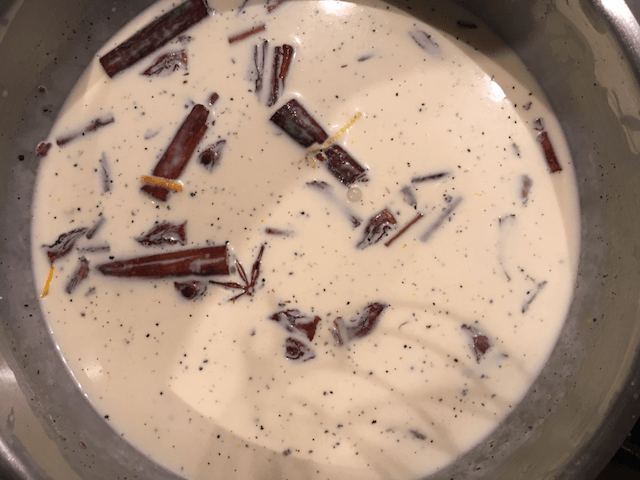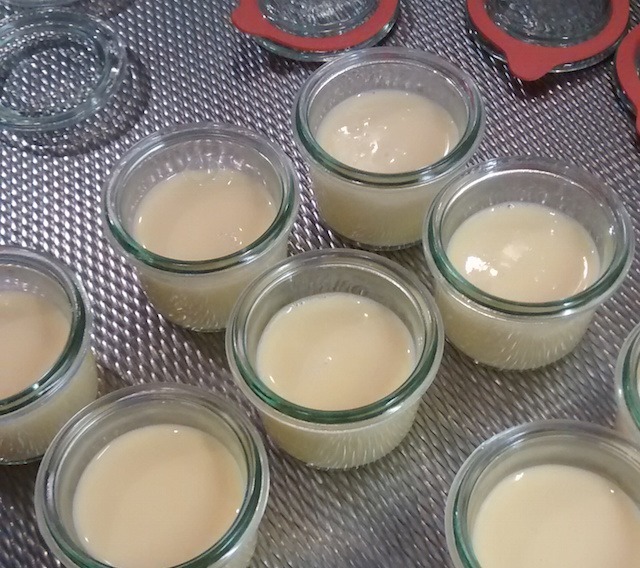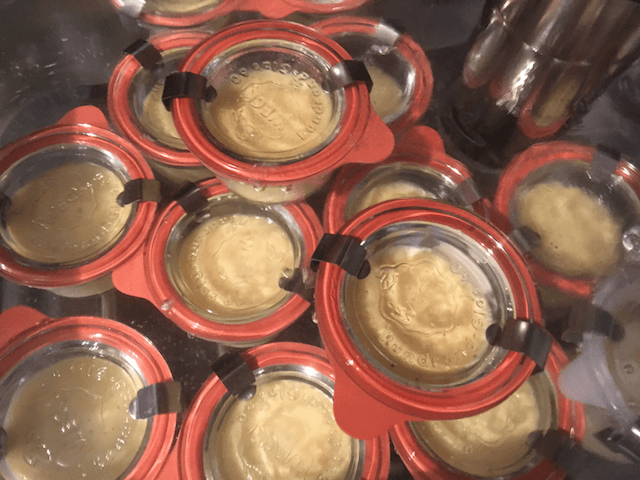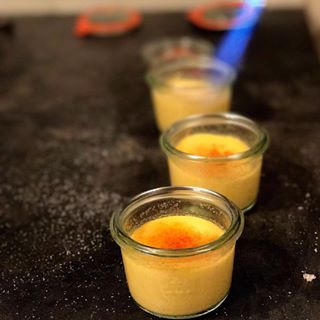Sous vide crème brûlée is an easy to make, yet delicious dessert. What is even better (personal opinion) is the Crema Catalana version of this recipe. Traditionally, crema Catalana is made with milk and some kind of thickener while crème brûlée relies on cream and eggs alone. Personally, I prefer the custard base recipe of crème brûlée with the flavors of crema Catalana; so this recipe is a combination of both.
This recipe is enough to fill around 12 small jars and can be made a few days in advance.
Ingredients
- 130g Egg yolk
- 500g Heavy cream (35% fat)
- 75g Sugar + for dusting in last step
- Some salt
- 1 Vanilla pod or extract
- 1 Star anise
- 1-2 Cinnamon sticks (or ground cinnamon)
- Orange zest (from 1 orange)
- Citrus zest (from 1 citron) {: .ingredient-list}
You can scale the ingredients according to the size of your jars. I’ve used this recipe to fill approximately 12 small jars.
Required materials
- Small canning jars (I use traditional small Weck jars), or zip lock bag (see step 3)
- Large pot or container to hold all the jars
- Sous vide setup (preferred, I use an Anova, but any brand will do.) or thermometer
- Blowtorch {: .material-list}
Time to make
30 minutes active time, 1 hour cooking, 5 minutes before serving.
Recipe
Step 1: infuse the cream
Add the zest, cinnamon, vanilla and anise to the cream. If used, you can also add the vanilla pod next to the seeds. Heat the cream slowly in a small pot to let it infuse with all the aromatics. Don’t let it cook. A temperature around 70°C is okay.

Infuse the cream using the aromatics to create the typical flavour of a Crema Catalana.
Step 2: Combine
Combine the egg yolk, sugar and salt. Whisk until smooth.
After heating the cream, sieve and temper the eggs by slowly pouring the warm heavy cream into your mixture. If you go to fast your eggs will turn in some sweet form of scrambled egg.
Let the mixture set for 10-15 minutes to let bubbles rise to the top. Remove any bubbles from the top with a sieve or slotted spoon.
Step 3: Fill jars
Make sure that your jars are very clean. Slowly fill each of your jars with the mixture. You can use a scale if you want to be exact. Poor from a low height to minimise the forming of any bubbles.
I’ve used Weck jars but other canning jars are also possible (e.g. Mason jars). Make sure that they are able to release air during the cooking process and not let water in.
Alternatively, it is also possible to use a zip lock bag instead of the jars. Pour the mixture in to a zip lock bag and hang the bag in to the water bath. During cooking, roughly every 10 minutes, agitate the bag to make sure that the mixture cooks evenly. After cooking, transfer the warm mixture to a blender and blend shortly until smooth. The blended cream can then be poured in to a serving container of your choosing.

Fill each jar with an equal amount and make sure not to fill them completely.
If there are any bubbles at the top of your mixture you can carefully remove them with a blow torch. Bubbles do not interfere with the cooking process but do make the end-result looking less smooth.
After filling, close each jar. In case of Weck jars, make sure that the rubber bands are correctly placed else you risk that they will fill up with water during the cooking process. Mason jars should not be closed very tight or air won’t be able to escape.
Step 4: Cook
Heat a water bath to 80 °C. The exact temperature is important; to hot and your eggs will start to curdle, to low and the custard will not set. There are two methods:
- (Preferred and most easy method) Sous vide: Use your preferred sous vide equipment to heat a large enough water bath to contain all the jars.
- Using a large pot: The recipe can also be made without sous vide equipment, though it will be a bit harder. Heat a large pot (preferably with a thick bottom) on the stove and monitor the temperature with an external thermometer. Try to get the temperature as close as 80 °C. This method is easier with an electric stove. With gas stoves it can be more difficult to get an even heating of the water. I’ve used this technique for my crème brûlée recipe.
Add the jars to the water bath, cook for 1 hour. Do not be afraid of any bubbles that release from the jars, this is normal.

Cook the jars in a water bath for 1 hour.
Step 4: Cool
Remove the jars from the water bath and cool them in a water/ice bath. Do this carefully, there is a small risk of breaking your jars due to the change in heat.
Store the jars closed in the fridge until serving. The Crema Catalana can be made a few days in advance, but make sure to leave the jars closed.
Step 5: Brûlée
Just before serving, open the jars and add regular granulated sugar. A finely grained sugar will result in a more even sugar layer. If there is moist on top of your cream you can remove it carefully with some kitchen paper. Use a blow torch to carefully create a “brûlée” topping on your custard. Be generous with the amount of sugar, you will see that this helps create a nice crust.
After making the caramel, cool the custards for a few minutes and serve. If you wait to long the caramel will eventually become soft.
